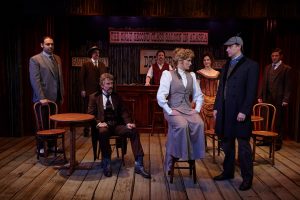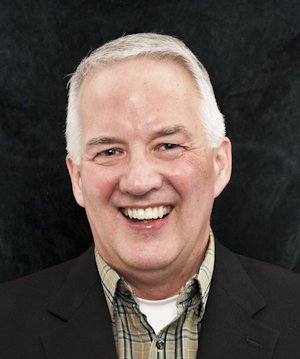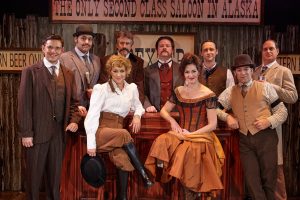When in Nome, Sherlock Holmes?
Sherlock Holmes is so popular that audiences recall a set of expectations whenever a production featuring his character is mounted. Holmes will wear a two-billed hat, he will sport a magnifying glass, and he will amaze his amanuensis, Dr. Watson, with his deductive powers in finding what often turns out to be a surprise villain. But, the recognition will be subtler, especially for long-time fans (and there are many of these). These fans will also want the Holmes speech patterns and body language to look right.
Playwright Joseph Vass, following in the footsteps of many who now find that they can use the Holmes character with impunity, has written a play with music (and lyrics, sometimes), called Sherlock Holmes and the Adventure of the Great Nome Gold Rush. The play features a number of clever ideas that are sure to entertain audiences but also some lumpiness in the writing of this world premiere that will surely disappoint some Holmes fans.
While most of the Holmes stories take place in England, it was not unknown for Holmes to travel. Heading off to Nome, Alaska, during the height of the gold rush would have been quite an undertaking, but the story is firmly rooted in Jolly Olde, even though only the beginning and the coda take place there.
Reginald Ingram (Julian Diaz) has been convicted of murder and sentenced to be executed. The evidence looks clear to prosecutor Edmond Pike (Richard Baird), even the famous Sherlock Holmes has testified at the trial in Ingram’s behalf, stating that Ingram has to be innocent because the coroner’s estimate of the victim’s time of death is off and Ingram has an alibi for the time of death that Holmes (Jason Maddy) fixes. But, Holmes’ evidence for his assertion comes from a science he calls “forensic entomology,” the study of the life cycle of the kinds of bugs that invade bodies after they are dead. Pike poo-poohs Holmes’ theory, and the jury doesn’t believe it, either.
But, there are some clues that don’t completely fall into place, including a map and a deed to a gold mine in Alaska. With Ingram’s execution impending, Watson (Nicholas Mongiardo-Cooper) takes off for Nome, hoping to find some motive in these documents for another killer, one whose identification will exonerate Ingram. There, he finds the legendary Wyatt Earp (Mr. Baird, again) and his wife, Josephine (Jacquelyn Ritz), who own a bar and lodge and who, coincidentally, stand for a kind of rough justice in a territory where the official judge (John Tessmer) has been corrupted by Alexander McKenzie (Andrew Barnicle), who is trying to corner the gold market through strong-arm tactics involving a shady character named Ace Dolan (Louis Lotorto). One of his proposed victims is Charlotte Valcour Amason (Katie Karel), a widow who has a claim to a mine within the area that is part of the map Watson brings along.
Of course, Holmes shows up and solves the case, as well as another local murder – and the solution is a clever one. In the best tradition of these sorts of tales you’ll not get any clues from me.
 It is interesting that Mr. Vass has included Wyatt Earp in his formulation, as Earp was, indeed in Nome at the time the play is set. And, the cast has much fun playing multiple roles, sometimes switching from British accents to those of the frontier west. There are some disguises and some things turn out not to be as thought. Audiences are sure to find the plot to be very watchable.
It is interesting that Mr. Vass has included Wyatt Earp in his formulation, as Earp was, indeed in Nome at the time the play is set. And, the cast has much fun playing multiple roles, sometimes switching from British accents to those of the frontier west. There are some disguises and some things turn out not to be as thought. Audiences are sure to find the plot to be very watchable.
[quote]there are some clues that don’t completely fall into place…[/quote]
On the other hand, I hope that Mr. Vass will revisit some of his dramaturgy and some of the language he uses to facilitate transitions. He several times gets to songs by having one of his characters suggest that a song be played, instead of having them integrated better into the script. The words he puts into Holmes’ and Dr. Watson’s mouths don’t always ring true. One character keeps punning, and while they are mostly funny (Nome gets punned on Rome a lot) they don’t have much to do with anything in a style of writing that doesn’t waste prose on non sequiturs. And, after a perfectly fine trial scene where the Nome murder case is solved, Mr. Vass tacks on a long coda back in England that seemed not entirely necessary, to me, at least.
Director David Ellenstein knows that Sherlock Holmes stories have to be light on their feet and fun to watch. Mostly, he succeeds in evoking both of these qualities from a cast with no weak link (though, I’d say that perhaps Mr. Baird has a bit more fun than anyone else). Scenes shift quickly, which can be a challenge for this theatre, so designer Marty Burnett has needed to settle for using red curtains and establishing playing areas at the far sides of the stage, which makes a few scenes difficult to see from a few seats (better to sit further back for this one, I think). Matthew Novotny’s lighting design helps a lot, and Matt Lescault-Wood’s sound design masters several challenges (pianos and violins that need playing while the actors fake doing so, voices that come from the audience). Jillian Frost has coached the dialects quite nicely, and Elisa Benzoni has designed better-than-serviceable period costumes.
At the very least, audiences should have a fine time, and the purists should have some nits to pick with their theatre companions after the performance.
[box]Performs Sundays and Wednesdays at 7pm, Thursdays – Saturdays at 8pm, and Saturdays and Sundays at 2pm in Solana Beach. There is plenty of free parking close to the theatre. Tickets range from $39 – $50, with discounts for students, seniors, and military. This review was based on the opening night performance on January 16.

In addition to reviewing theatre for San Diego Story, Bill also reviews for TalkinBroadway.com. He is a member of the San Diego Theatre Critics Circle and the American Theatre Critics Association. Bill is an emeritus professor in the School of Journalism and Media Studies at San Diego State University.



